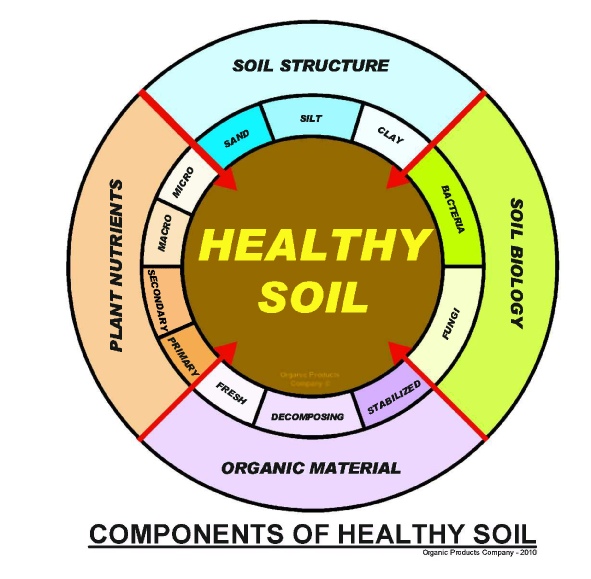


Organic Gardening –
Components of Healthy Soil
There are many articles written about soil and soil health and how it is necessary for growing organic produce. Most of these articles concentrate on just one or two of the things that are needed for good soil while ignoring others that are just as important. Truly healthy organic soil takes time to build. For a farmer to get organic certification it takes three years away from all chemicals and synthetic fertilizer to qualify.
Good healthy soil can be broken down into four major contributors; they are 1) Soil Structure, 2) Plant nutrients, 3) Organic material and 4) Soil Biology. These four items in a proper balance will provide your plants most of what they need to produce a nutritious end product.
The balance of these four items can vary considerably depending on the plants you are growing and local conditions.
Much is said about soil pH and what you should be looking for as the ideal pH. First look at what you are planning to grow, make sure they require similar conditions before you put anything in the ground. You will need to adjust your soil to their needs. Mixing acid loving plant with alkaline loving ones does not work well.
A pH of 6.4 is where the maximum availability of all plant nutrients but, many sources recommends 6.5 pH as a minimum and 7.2 pH as a maximum.
Another major factor which can affect the four items mentioned above is the water you use in gardening. Rain water is in most cases the best because it is mostly neutral in pH though you need to be careful of the surface it is collected off of, in that it can pick up harmful minerals. Chlorinated city water will kill soil biology. If this is what you have, let it sit over night in an open container or use devices that break the water into fine sprays, this will dissipate most of the chlorine.
Soil Structure: I break this down into three categories which are 1) sand, 2) silt and 3) clay.
1) Sand is a naturally occurring material composed of small rock and mineral particles. It does not hold water or nutrients well by itself. Sand needs a minimum of 2% organic material in most cases to become productive. In highly arid areas it can be less.
2) Clay is a naturally occurring material composed primarily of fine-
3) Silt is soil or rock derived granular material of a grain size between sand and clay. It holds water and air but needs organic matter to make it fertile.
Organic Material: Without a continuous supply of fresh organic material soil will loose its nutrient balance and will not provide quality produce. Organic material can be broken down into three categories which are 1) fresh, 2) decomposing and 3) stable. All three categories are needed to keep soil healthy.
The amount of organic material in the soil varies with temperature and moisture. High temperatures and adequate moisture requires the highest supply of fresh organic material.
1) Fresh organic material added to soil needs to be made up of healthy, pathogen free material that meets the needs of the plants you are growing. Too much material with either to high a pH or to low can change your soils pH. Pine needles are great but they have a very low pH and can adversely affect some crops. Do not use meat scraps, milk products or animal waste of animals that eat meat.
The regular addition of organic matter is important to provide food for microorganisms, insects, worms, and other organisms, and as habitat for some larger organisms. Soil organisms can degrade potential pollutants, help control disease, and bind soil particles into larger aggregates. Well-
Fresh organic matter can cause problems. It can draw needed nitrogen out of the soil creating a temporary nitrogen deficiency for crops. Carbon-
The biology is breaking down the easy to decompose portions such as sugars, starches and proteins.
2) Decomposing organic matter or the second stage of decomposition is the soil biology starts breaking down more complex items such as cellulose, lignin’s and others more complex materials that may take several years to decompose. This group also breaks down even more complex matter such as waxes and phenols that can take up to ten years to decompose. Specific enzymes, not commonly produced by many microorganisms are required to breakdown these compounds.
3) Stabilized organic matter is the organic matter that has been transformed into new, very complex compounds. After years or decades of these transformations, what remains are large, complex compounds that few microbes can degrade. Other compounds become bound inside soil aggregates where microbes cannot reach. These hard-
Plant Nutrients: I break plant nutrients into four groups being 1) Primary, 2) Secondary, 3) Macro and 4) Micro. All are needed in varying amounts and need to be in a form which plants can absorb. All nutrients need to be transformed into a plant available form. Iron is in many soils in abundance but is in a form that plants cannot use so it needs to be provided in a chelated form. There can be many imbalances between various nutrients that make one or the other unavailable to the plant so you have to be very careful in keeping a useful balance.
1) Primary nutrients are nitrogen (N), phosphorus (P), and potassium (K). These major nutrients use large amounts for plant growth and survival.
2) Secondary nutrients are calcium (Ca), magnesium (Mg), and sulfur (S). Calcium and Magnesium are added when lime is applied. Sulfur is usually found in sufficient amounts from the slow decomposition of soil organic matter, an important reason for not throwing out grass clippings and leaves and other organic material.
3) Macronutrient is silicon (Si). Not considered as essential by many it is found in many plants. The beneficial effects of adequate Si include decreased susceptibility to fungal pathogens (and insects); amelioration of abiotic stresses, and increased growth in some plants.
4) Micronutrients are those elements essential for plant growth which are needed in only very small (micro) quantities. The micronutrients are boron (B), copper (Cu), iron (Fe), chloride (Cl), manganese (Mn), molybdenum (Mo), selenium (Se), sodium (Na) and zinc (Zn).
Soil Biology: Soil biology breaks down into two parts which directly relate to plant life are 1) bacteria and 2) fungi. To look at the total picture of soil biology the soil food web you need to look at www.soilfoodweb.com and other sites that look at the total ecological system. A truly healthy soil is impossible without soil biology. We have mistreated the soil by using synthetic fertilizers, fungicides, herbicides and pesticides that kill soil biology thus lowering the quality of our crops and damaging the earth’s ecosystem. You can add nutrients to your soil but without soil biology much of it will never be used by your plants.
1) Bacteria are able to perform an extremely wide range of chemical transformations; including degradation of organic matter, disease suppression, disease, and nutrient transformations inside roots (e.g. reducing bacteria in roots, bacteria cause nitrogen fixation).
Bacteria are the organisms in soil that are mainly responsible for transforming inorganic particles from one chemical form to another. Their external digestion means that some of the metabolites released by the use of extracellular enzymes may be used by other organisms, such as plants. The bacteria gain nutrients and energy from these processes and provide other organisms with suitable forms of chemicals they require for their own processes. For example, in the conversions of nitrate to nitrite, sulphate to sulphide and ammonium to nitrite that plants can use.
2) Fungi colonize the root zones of plants and surrounding soil is beneficial for plant growth. As the fungi enlarge and weave through the root zones, they send threads, far from the roots, to colonize the soil and produce water stable aggregates that link up as macro-
Summery: Soil health is complex and varies widely with the plant grown, temperature, moisture availability, soil pH and others.
Soil tests should be done to show what needs to be done to balance your soil. Our local government extension service office should be able to assist you with this.
Brining soil back to health after it has been subjected to chemical abuse can take several years, but with proper techniques it can be done and is well worth the effort.
Healthy soil with a proper amount of organic material will compact so be careful about where you walk. Many set up their garden so there are fixed pathways positioned so that they are reach everything withour actually walking on productive areas.
Recommendations:
Fertilizer and other additives:
Fish hydrolysate fertilizer contains all the vitamins, proteins, amino acids, enzymes, growth hormones, and micro nutrients naturally found in whole fish. The nitrogen and other nutrients are chelated, so they are readily available for the plant's consumption. Hydrolysate Co of America, LLC (www.multibloom.com) produces a fresh water hydrolysate from farm raised catfish that meets most organic growing requirements.
Natural Humates contain Humic and Fulvic acid, many trace elements and beneficial soil biology and food for the biology. They can lock up harmful chemical compounds in the soil and reduce them to less harmful substances. They can reduce your use of fertilizer by holding in till needed and reduce water usage because they can hold many times their weight water. Organic Products Company produces a dry product called AgriPro Natural that I use in the potting mix. They also make a liquid product (Turf and Garden Pro) that I use as a foliar spray and as a drench. Both are found on (www.turfprousa.com) .
Kelp and other sea plants also contain relatively concentrated amounts of plant auxins, growth regulators and stimulants, such as indole-
( www.maxicrop.co.uk/ ) that I get from a local hydroponics store.
Other Organic Fertilizers besides fish hydrolysates come in a very wide range of products from blood meal to alfalfa meal. They very greatly in the amount of N-
Compost Teas have can be very useful but, be careful of what is used in the tea brewing to avoid harmful pathogens plu they have a very limited shelf life.
Worm Tea has many benefits and works well as a soil additive.
Herb Teas are becoming very popular, especially for pest control with elements such as chamomile, yarrow tops, oak bard and stinging nettles, to name a few.
Molasses can provide carbohydrates to feed soil biology, plus it is a good sticking agent. It also is a good chelating agent and contains a number of essential elements.
When buying products for eco-
If you have any questions please contact jloepp@turfprousa.com or call (407)340-
On-
Intellectual property of J.R. Loepp -
Web Sites for Organic Growing:
(3007A) 9/17/2010


Copyright © 2010 Organic Products Company. All rights reserved.